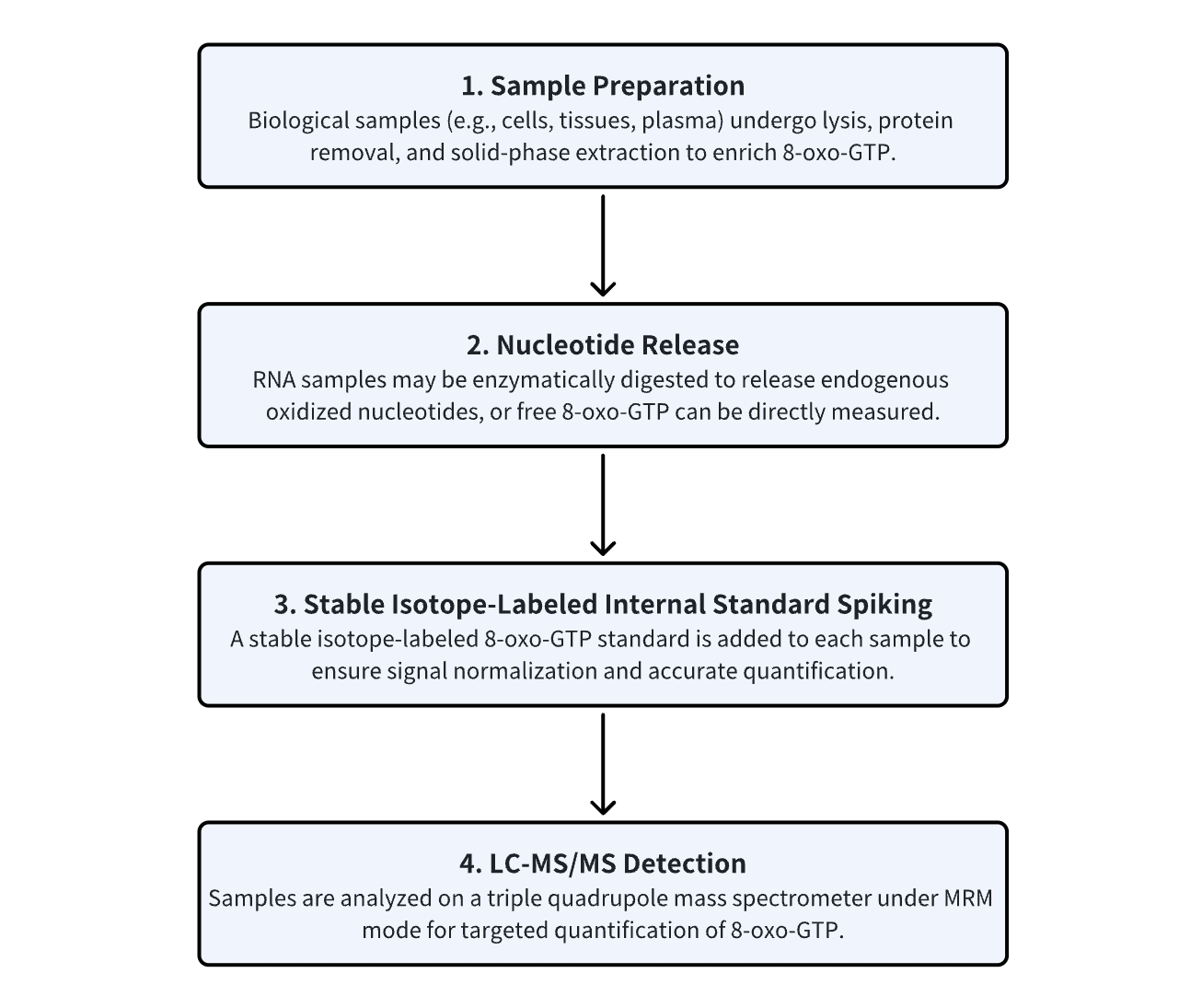8-oxo-GTP Quantitative Analysis Service
8-oxo-GTP (8-oxo-guanosine triphosphate) is a major oxidative product formed when intracellular GTP is modified under reactive oxygen species (ROS) stress. It is recognized as one of the most biologically significant biomarkers of nucleotide oxidation. Under oxidative stress, 8-oxo-GTP can accumulate to high levels and become erroneously incorporated into RNA transcripts, leading to mistranslation, production of dysfunctional or toxic proteins, and disruption of normal cellular homeostasis. Moreover, 8-oxo-GTP may abnormally bind to GTPases such as RAS and Rho, interfering with critical GTP signaling pathways and triggering aberrant cell proliferation, migration, or apoptosis. Elevated levels of 8-oxo-GTP have been observed in a variety of disease models, including neurodegenerative disorders (e.g., Parkinson’s disease and Alzheimer’s disease), cancers, cardiovascular diseases, and inflammation-related conditions. As such, 8-oxo-GTP serves as a crucial molecular target for studies on oxidative damage mechanisms, drug efficacy evaluation, and early disease screening.

Figure1. Structure of 8-oxo-GTP
Service at MtoZ Biolabs
To support researchers in uncovering the functional roles of 8-oxo-GTP in oxidative damage and disease progression, MtoZ Biolabs offers a high-sensitivity 8-oxo-GTP quantification service powered by our advanced LC-MS/MS platform. By combining stable isotope-labeled internal standards with rigorous sample preparation protocols, our service achieves precise quantification at the picogram level. This assay is compatible with a wide range of biological matrices, including cells, tissues, blood, and cerebrospinal fluid. Whether for basic research, mechanistic studies, drug screening, or biomarker discovery, our robust analytical approach provides reliable data to illuminate the molecular links between RNA oxidation and disease. At MtoZ Biolabs, we are committed to advancing life science research through high-quality, actionable insights.
Analytical Workflow
MtoZ Biolabs’ 8-oxo-GTP quantification service is powered by a high-sensitivity liquid chromatography–tandem mass spectrometry (LC-MS/MS) platform, combined with a stable isotope-labeled internal standard strategy for precise detection of oxidized RNA nucleotides. Following acid or enzymatic hydrolysis, nucleotides are released from the sample, purified via solid-phase extraction (SPE), and analyzed by LC-MS/MS. Using multiple reaction monitoring (MRM), we specifically monitor the characteristic precursor-to-product ion transition of 8-oxo-GTP (e.g., m/z 522 → 159). This approach enables accurate quantification while effectively distinguishing 8-oxo-GTP from structurally related compounds such as GTP and 8-oxo-dGTP, minimizing signal interference.

Figure2. Analytical Workflow of 8-oxo-GTP Quantification Service
Why Choose MtoZ Biolabs?
✅Targeted Detection of RNA Oxidative Damage
Our assay is specifically designed to quantify 8-oxo-GTP, a key marker of RNA oxidation, overcoming limitations of conventional GTP-based detection. This enables in-depth investigation of oxidative stress–induced functional disruptions and disease-related mechanisms.
✅Optimized Nucleotide Enrichment Strategy
We utilize solid-phase extraction and ion-exchange purification methods tailored for phosphorylated small molecules. This enhances the recovery and sensitivity of 8-oxo-GTP detection and supports compatibility with diverse sample types.
✅High-Specificity MRM Monitoring System
Custom-developed MRM transitions paired with stable isotope-labeled internal standards ensure accurate discrimination of 8-oxo-GTP from structural analogs, delivering clean signal profiles and reliable quantification.
✅One-Time-Charge
Our pricing is transparent, no hidden fees or additional costs.
✅High-Data-Quality
Deep data coverage with strict data quality control. AI-powered bioinformatics platform integrates all 8-oxo-GTP quantitative analysis service data, providing clients with a comprehensive data report.
Applications
1. RNA–Protein Interaction and Regulation Studies
2. Aging-Related Oxidative Biomarker Research
3. Oxidative Stress Assessment in Cardiovascular Disease
4. High-Throughput Drug Screening Platform Development
5. Epigenetic and Transcriptional Regulation Mechanism Studies
Sample Submission Suggestions

For other sample types, please contact us prior to submission. Our technical team will provide tailored pretreatment recommendations based on your specific sample characteristics.
Deliverables
What Could be Included in the Report?
1. Comprehensive Experimental Details
2. Materials, Instruments, and Methods
3. Total Ion Chromatogram & Quality Control Assessment (project-dependent)
4. Data Analysis, Preprocessing, and Estimation (project-dependent)
5. Bioinformatics Analysis
6. Raw Data Files
Related Service
Targeted Metabolomics Analysis Service
Carotenoids Analysis Service | UPLC-MS
Glucosinolates Analysis Service
Carbohydrates Analysis Service
Organic Acids Analysis Service | GC - MS
How to order?







